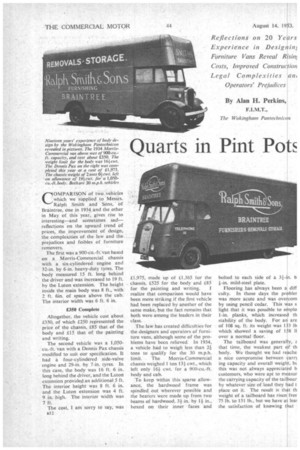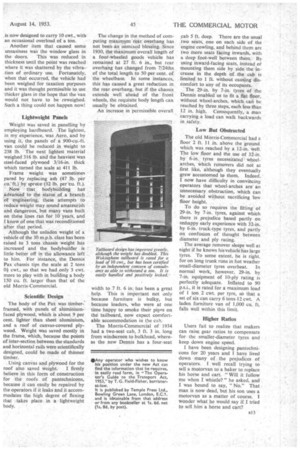uarts in Pint Pots
Page 46

Page 47

If you've noticed an error in this article please click here to report it so we can fix it.
Reflections on 20 Years Experience in DesignilQ Furniture Vans Reveal Risin. Costs, Improved Construction Legal Complexities ani Operators' Prejudices By Alan H. Perkins,
F.I.M.T., The Wokingham Pantechnicon COMPARISON of tWo .vehicles which we supplied to Messrs. Ralph Smith and Sons, of Braintree, one in 1934 and the other in May Of this year, gives rise to interesting—and sometimes sad— reflections on the upward trend of prices, the improvement of design, the complexities of thelaw and the. prejudices and foibles of furniture
removers.
The first was a 900-cu.-ft. van based on a Morris-Commercial chassis with a six-cylindered engine and 32-in. by 6-in, heavy-duty tyres. The body measured 15 ft. long behind the driver and was increased to 19 ft. by the Luton extension. The height inside the main body was 8 ft., with 2 ft. 6th. of space above the cab. The interior width was 6 ft. 6 in.
£350 Complete
Altogether, the vehicle cost about £350, of which £250 represented the price of the chassis, £85 that of the body and £15 that of the painting and writing.
The second vehicle was a 1,050 cu.-ft. van with a Dennis Pax chassis modified to suit our specification. It had a four-cylindered side-valve engine and 29-in. by 7-in. tyres. In this case, the body was 16 ft. 6 in. long behind the driver, and the Luton extension provided an additional 5 ft. The interior height was 8 ft. 6 in. and the Luton extension was 4 ft. 9 in. high. The interior width was
7 ft. • The cost, I am sorry to say, was
£1,975, made up of £1,365 for the chassis, £525 for the body and £85 for the painting and writing. I realize that comparison would have been more striking if the first vehicle had been replaced by another of the same make, but the fact remains that both were among the leaders in their class.
The law has created ditticulties-for the designers and operators of furniture vans, although some of the problems have been relieved. In 1934, a vehicle had to weigh less than 2,1 tons to qualify for the 30 m.p.h. limit. The Morris-Commercial chassis weighed 1 ton 13i cwt., which left only 16-i cwt. for a 900-cu.-ft. body and cab.
To keep within this sparse allowance, the hardwood frame was spindled out wherever possible and the bearers were made up from two beams of hardwood, in. by I in., boxed on their inner faces and bolted to each side of a 3i-in. b i-in, mild-steel plate.
Flooring has always been a ditf culty. In those days the probler was more acute and was overcom by using pencil cedar. This was s light that it was possible to emplo 1-in, planks, which increased th stability of the body. For an are of 108 sq. ft. its weight was 133 lb which showed a saving of 158 It over a normal floor.
The tailboard was generally, that time, the weakest part of th body. We thought we had reache a nice compromise between earn ing capacity and overall weight, bi this was not always appreciated b customers, who were apt to measur the carrying capacity of the tailboar by whatever size of load they had t place on it. The result is that th weight of a tailboard has risen fror 75 lb. to 151 lb., but we have at lea the satisfaction of knowing that
is now designed to carry 10 cwt., with an occasional overload of a ton. Another item that caused some uneasiness was the window glass in
the doors. This was reduced in thickness until the point was reached where it was shattered by the vibration of ordinary use. Fortunately, when that occurred, the vehicle had been weighed for taxation purposes and it was thought permissible to use thicker glass in the hope that the van would not have to be reweighed. Such a thing could not happen now!
Lightweight Panels Weight was saved in panelling by employing hardboard. The lightest, in my experience, was Aero, and by using it, the panels of a 900.cu.-ft. van could be reduced in weight to 238 lb. The next lightest material weighed 316 lb. and the heaviest was steel-faced plywood 3/16-in, thick which turned the scale at 411 lb.
Frame weight was sometimes pared by replacing ash (47 lb. per cu. ft.) by spruce (32 lb. per cu. ft.).
Now that bodyhuilding has advanced to the status of. a branch of engineering, these attempts to reduce weight may sound amateurish and dangerous, but many vans built on these lines ran for 10 years, and r.know.of one that was reconditioned after that period.
Although the unladen weight of a Vehicle of the 30 m.p.h. class has been raised to 3 tons chassis weight has increased and the bodybuilder is little • better off in the allowance left to him. For instance, the, Dennis Pax chassis tips the scale at 2 tons 01 cwt., so that we had only 3 cwt. more to play with in building a body 150 Cu. ft. larger than that of the old Morris-Commercial.
Scientific Design The body of the Pax was timber:s framed, with panels of aluminiumfaced plywood, which is about 9 per cent. lighter, than sheet aluminium, and a roof of canvas-covered plywood. Weight was saved mostly in the frame, which, because the points of inter-section between the standards and horizontal rails were scientifically designed, could be made of thinner timber.
Using canvas and plywood for the
roof also saved weight. I firmly believe in this form of construction for the roofs of pantechnicons, because it can easily be repaired by the operators if it leaks and it accommodates the high degree of flexing that takes place in a lightweight body.
The change in the method of computing maximum 'tear, overhang has not been an unmixed blessing. Since 1930, the Maximum overall length of a four-wheeled goods vehicle has remained at 27 ft. 6 in., but rear overhang has changed from 7/24ths of the total length to 50 per cent, of the wheelbase. In some instances, this has caused a great reduction in the rear overhang, but if the chassis extends well ahead of the front wheels, the requisite body length can usually be obtained.
An increase in permissible overall
width to 7 ft. 6 in. has been a great help. This is important not only because furniture is bulky, hut because loaders, who were at one time happy to smoke their pipes on the tailboard, now expect comfortable accommodation in the cub.
The Morris-Commercial of 1934 had a two-seat cab, 3 ft. 3 in. long from windscreen to bulkhead, whereas the new Dennis has a four-seat cab 5 ft. deep. There are the usual two seats, one on each side of the engine cowling, and behind them are two more seats facing inwards, with a deep foot-welt between them. By using inward-facing seats, instead of mounting them side by side the increase in the depth of the cab is limited to 1 ft. without causing discomfort to any of its occupants.
The 29-in. by 7-in. tyres of the Dennis enabled us to fit a flat floor, without wheel-arches, which can be reached by three steps, each less than 12 in. high. Consequently, a man carrying a load can walk backwards in safety.
Low But Obstructed The old Morris-Commercial had a floor 2 ft. 11 in. above the ground which was reached by a 12-in. well. The low floor and the use of 32-in. by 6-in. tyres necessitated wheelarches, Which removers did not at first like, although they eventually grew accustomed to them. Indeed.
now have difficulty in convincing operators that wheel-arches are an unnecessary obstruction, which can be avoided without sacrificing low floor height.
To do so requires the fitting of 29-in. by 7-in. tyres, against which there is prejudice based partly on unhappy early experience with 32-in. by 6-in. truck-type tyres, and partly on confusion of thought between diameter and ply rating.
The average remover sleeps well at night if he knows his vehicle has large tyres. To some extent, he is right, for on long trunk runs in hot weather small-diameter tyres overheat. In normal work, however, 29-in. by 7-in, equipment of 10-ply rating is perfectly adequate. Inflated to 90 p.s.i., it is rated for a maximum load of 1 ton 2 cwt. per tyre, so that a set of six can carry 6 tons-12 cwt. A laden furniture van of 1,000 Cu, ft. falls well within this limit.
Higher Ratios
Users fail to realize that makers can raise gear ratios to compensate for the smaller-diameter tyres and keep down engine speed.
I have been designing pantechnicons for 20 years and I have lived down many of the prejudices of operators. I well recall trying to sell a motorvan to a baker to replace his horse and cart. "Will it follow me when I whistle?" he asked, and I was bound to say, "No." That man is now dead, but his son uses a motorvan as a matter of course. I wonder what he would say if I tried to sell him a horse and cart?




















































































